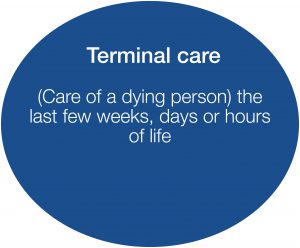Terminal care

For out of hours advice:
Royal Trinity Hospice, 020 7787 1000
See the sections below for relevant information and document links
The Dying Phase
The terminal / actively or imminently dying – Living Well Until the Very End. Information about what happens during the dying phase, what to look out for and how you can help.
Care of the Dying Flowchart
Care of the dying person flowchart
This flowchart is aimed to aid the clinical (medical, nursing and therapy) teams to ensure all areas for care have been identified when a patient is recognised as entering the terminal / active phase of dying. It is structured around the NICE guidelines and takes into account the Five National Priorities of Care for a Dying Person (‘One Chance to Get it Right’, Leadership Alliance for the Care of Dying People 2014).
This should be used to ensure a full, complete and thorough individualised care of the dying person plan is put into place.
Care of the Dying Person Plan – Information for nurses
Care of the Dying Person Plan: achieving priorities of care in the last hours and days of life – information for nurses
This individualised Care Plan for the dying person is for nurses looking after those patients who have been recognised as entering the terminal / active phase of dying by the clinicians. It is based around decision-making for the five priorities of Care of the Dying Person. Family may too have a view. Nurses should use this to ensure all areas of care are addressed accordingly.
IMPORTANT NOTE:
If a person who is on the Care of the Dying Plan makes a clinical improvement the plan can be paused, revised or reversed. The reasons MUST be clearly documented. All appropriate observations, interventions, treatments are re-assessed and restarted. This needs to be clearly documented in the patient EPR record. Communication must be excellent at all levels, especially at handovers and communicating with family.
Daily Care Considerations
The document gives guidance and best practice as to what care needs should be addressed when looking after a dying person.
- Maintain Excellence in Nursing Care
- Nutrition and Hydration
- Symptom Control – Pain; Breathlessness; Nausea & Vomiting; Restlessness & Agitation; Chest Secretions
- Spiritual & Psychological Needs
- Communication & Document
- Family Considerations
Nursing Symptom Control Observation Sheet
Nursing symptom control observation sheet
*Note that this is now available on EPR
When the multi-disciplinary team (MDT) deem that someone is dying THEN:
- This document replaces the current NEWS record.
- It should be used to OBSERVE & ASSESS symptoms and document any action taken or not taken.
- It prompts and ensures ongoing review. The frequency of the nursing review is dictated by the needs of the moment and how symptomatic the patient is, i.e., 4 hours if any symptom is none or mild; 1 hourly if any symptom is moderate or severe.
- The nursing observation sheet is available on EPR under nursing forms. If the paper based version is being used then please scan onto EPR after it is no longer needed.
Symptom Management
This document contains information on symptom control for all symptoms, as well as guidance on symptom control using non-oral, non parenteral routes of medication administration during COVID-19.
Managing Controlled Drugs (CD’s)
Management of Controlled Drugs in the clinical area Policy
Prescribing and Supply of Urgently Required Controlled Drugs Out of Hours (Within Hours for LTC)
Syringe Driver Information
There is one syringe driver, on loan from Royal Trinity Hospice. It is kept in a box in the Point of Care room, which is accessed by the Clinical Response Service.
Setting up a T34 McKinley syringe driver pump – PowerPoint presentation
Subcutaneous insertion of BD Saf-T-Intima safety system – PowerPoint presentation
Important resources:
Communication with the Family
Talking to relatives: a guide to compassionate phone communication
e-learning modules relating to Care of the Dying Person (through HEE)
Coming soon! eLearning modules on our Learning Management System
